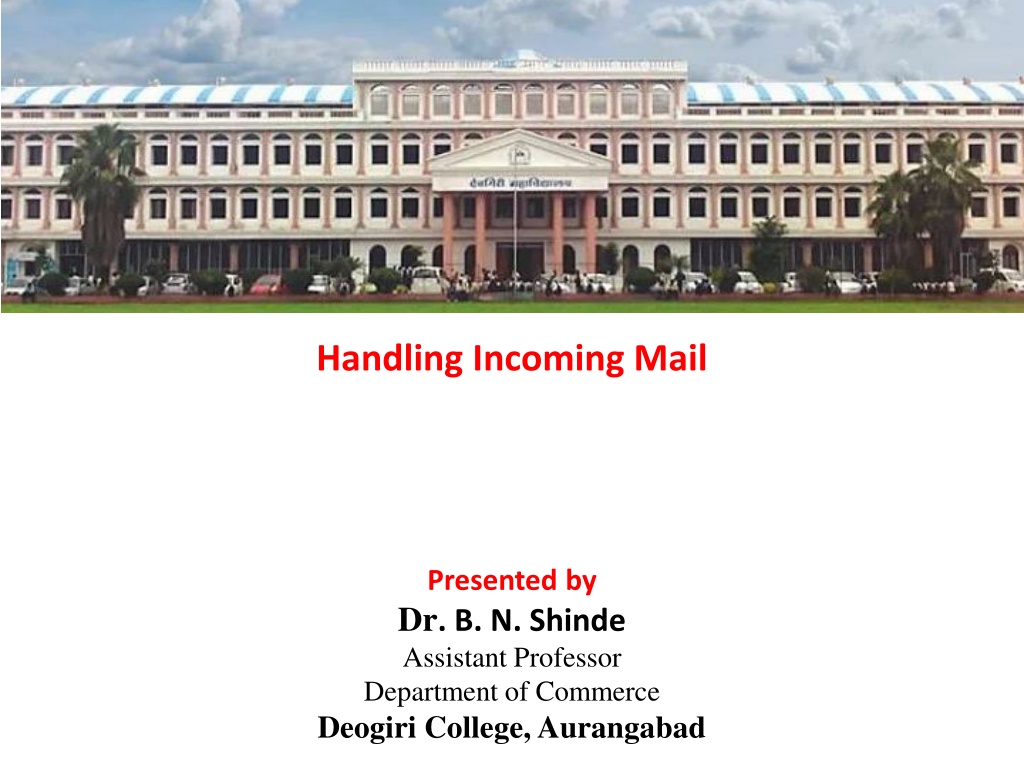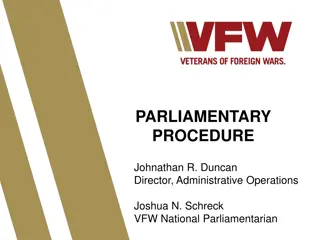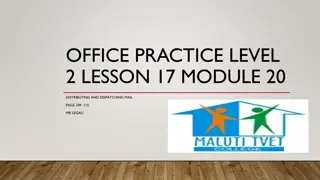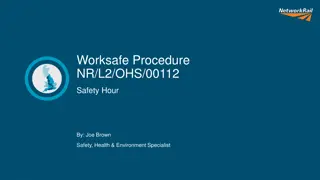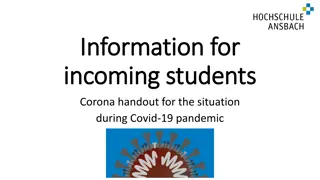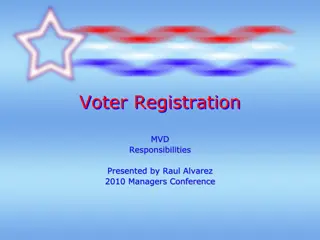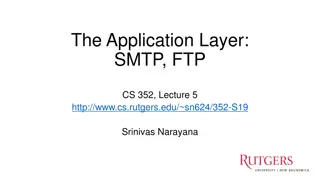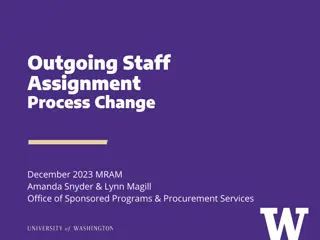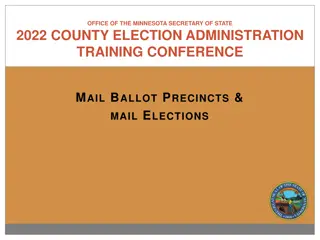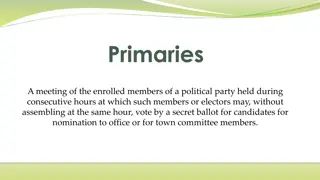Efficient Procedure for Handling Incoming Mail in Offices
To effectively manage incoming mail in offices, a structured approach is vital. The process involves receiving the mail, sorting it, opening it, scrutinizing contents, and stamping it with the date of receipt. Proper handling ensures timely delivery and management of correspondence, enhancing efficiency in office operations.
Download Presentation

Please find below an Image/Link to download the presentation.
The content on the website is provided AS IS for your information and personal use only. It may not be sold, licensed, or shared on other websites without obtaining consent from the author. Download presentation by click this link. If you encounter any issues during the download, it is possible that the publisher has removed the file from their server.
E N D
Presentation Transcript
Handling Incoming Mail Presented by Dr. B. N. Shinde Assistant Professor Department of Commerce Deogiri College, Aurangabad
Handling Incoming Mail Once it has been decided whether incoming or inward mail is to be centralized or departmentalized, it is essential to lay down an efficient procedure for its handling. The following routine is suggested for this purpose: I) Receiving the mail: Mail or dak is ordinarily delivered by the post office through it s postman twice or thrice a day. If a numbered post box or post bag has been rented, a messenger is sent to the post office at specified times to collect the mail. Some incoming letters may also be received through messenger or peons of other offices or departments. A suitable arrangement would have to be made to receive all such mail. In small offices, mail is received by the chief executive or his secretary or receptionist. But in big offices having a separate mailing department, a clerk is entrusted with the responsibility of receiving the incoming mail. Whosever receives the incoming mail signs and acknowledges the receipts for registered mal, parcels or letters delivered by the peons of other offices etc.
Continue II) Sorting the mail: After the mail has been received in the mailing department, it should be sorted out before it is opened. It is easier to sort out sealed envelopes than different sized pieces of paper. Sorting may first of all done of private letters of the employees and of business letters. Business letters should be sorted out into three groups: A) Registered and unregistered letters or mails. B) Sealed and unsealed envelopes C) Confidential and urgent letters and other official letters. Sorted mails makes the delivery of letters convenient and quick.
Continue III) Opening the mail: The letters may be open by hand or by letter opening machines. A paper knife is mostly used in offices to slit open envelopes etc. If the number of letters is very large, a letter opening machines may be used with advantage. This machine has a revolving knife edge which slices a very thin piece of the side of an envelop and ensures its safe opening. It is advisable to shake the contents to the other side of the envelope before feeding it to the letter opening machine.
Continue Iv) Scrutiny of contents: After the removal of the contents from the opened envelopes, their contents should be scrutinized to find out for whom, and for which departments they are meant. The sorting of letters on a departmental basis is done at this stage. Before sending the mail to the concerned departments, the enclosures to the letter should be checked, compared and verified with the covering letter to find out whether they are in order or not. Sometimes the enclosures are cheques, bank drafts, postal orders or valuable documents. If any discrepancy or omission is found while scrutinizing them, the matter should be immediately brought to the notice of the mailroom supervisor.
Continue V)Stamping the mail: All letters received in the office should be stamped with the date of their receipts. Where the time of receipt is important, it should be noted on the communication. In some offices, mail is serially numbered. The stamping of the date may be done with rubber stamps. The time and serial number may be written by hand or with the help of dating numbering and time recording machines. Sometimes, a specially designed rubber stamp is used to provide for the noting of instructions for treatment as well as for the date and reference number. A design of such stamp is given below: INDO EURO EXPORTS NO Date Received Ackd Replied Filed .
Continue VI) Recording the mail: Many offices, particularly banks, municipal corporations, professional form, keep a record of each letter received by enering its particulars in a letter received book or Inward mail register. The particulars usually entered are: a) The serial number b) The date of receipt c) From whom received d) Subject e) Enclosure f) Initials of the person to whom the letter was handle over for attention. government offices and
Continue Inward Mail Register Sr. No. Date Sender s Subject Contents Departm ent Referred Date of Reply 1. 1998 July 1 Black and Burn co. ltd. East park Rd. Calcu Fantasy Ltd. Connaught Place. New Delhi Order Letter Sales July 1 2. Paymen t Letter and Cheque Account July 2
Continue VII) Distributing the mail: The last stage in handling the inward mail is its distribution to the concerned executive or departments. VIII) Follow up: Letters received should be properly attended to and answered or the necessary action should be taken thereon.
Handling Outgoing Mail Every organization sends out mail each day, and good office system ensures that it is done in the most economical and efficient manner. For reasons of efficiency and economy, the outgoing mail service should be centralized. In order that he may perform his job efficiently the mail supervisor, who looks after the outgoing mail should have a thorough knowledge of postal rules and regulations. The following routine is suggested for the handling of outgoing mail.
Continue I) Production: The production of outward letter or mail involves drafting or dictation and the typing of letters. All outward mail should be produced before dispatch. II) Signature and References: Every outward letter or mail should be signed, and the authority to sign office mail should be clearly defined. Ordinary routine letters, circulars or form letters may be signed by a junior executive or a correspondence clerk; but the important letters should be signed by departmental heads or the executive/ director concerned. Whosever sign the letter should verify and check its contents. The verification may also be done by a correspondence clerk or typist who should initial the letter; and then it may be signed by the executive concerned. Signature are placed in full on the originals.
Continue After the signature , the outgoing letters have to be marked with a reference number (code number ) or symbol or file number for future reference this is known as referencing. Every organization follows its own method of coding and referencing. For instance, a letter from the accounts department of an organization sent to a customer may have Accts/1053/95 where Accts stands for Accounts, 1053 is the serial number of the letter and 95 indicates the year 1995/ the reference as
Continue III) Collection of outward mail: In some offices different departments send letters duly typed, signed addressed and placed in envelopes to the mailing department, which dispatches them. However in many offices, the mailing departments messenger visits different departments at scheduled times and collects the mail from the trays marked outgoing mail and deposits it in the mailing department. In large offices, mail may be collected 3 to 4 times a day to ensure an even flow of work in the mailing department throughout the day. This improves the efficiencies of the dispatch section.
Continue IV) Entering mail in outward mail register: Before letters are posted a record of them should be entered in the outward mail register or dispatch register. The particulars usually entered in this register include: A) The serial number B) The date C) The contents of the letter D) The address of the receiver E) The name of the department sending the letters and F) The value of the stamps used
Continue V) Folding letters: The letters are now folded and inserted in their envelops. Before folding the letters, the address of the addressee should be noted down on the envelope in which folded letter inserted. VI) Preparing the Envelopes: After folding the letter is inserted in envelop which should be properly and correctly addressed. A complete and correct address ensures a quick and prompt delivery of the letter to the addressee. Pin code should be given. Addresses may be written by hand or typewritten or written with the help of addressing machines.
Continue VII) Sealing and Stamping: After preparing the envelope, the step is to seal it with an adhesive, gum or cello tape. In large organizations, huge volume of outward mail may be sealed with the help of sealing machine. The next step is to stamp the mail which is to be sent by post. This stamping should be done carefully, for over stamping causes loss and under stamping creates a bad impression about organization.
Continue VIII) Posting: Ordinarily, all stamped unregistered mail is put in the post box. Letters addressed to local correspondence are generally sent through messenger. Letters marked U. P. C. ( Under Postal Certificate), Registered recorded delivery or V. P. P. are delivered at the counter of the post office. The office may also make special arrangement of the dispatch of the urgent letters to the general post office or an RMS post office even after normal office hours.
